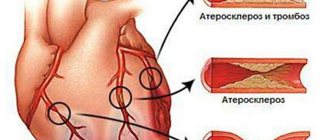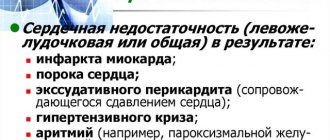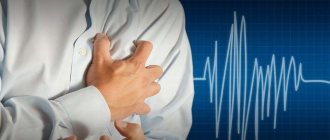5 / 5 ( 12 votes)
The article describes the manifestations of heart failure. The causes of the pathology, therapeutic and diagnostic measures are described.
Heart failure is a pathology accompanied by a violation of the main function of the heart - pumping. It becomes unable to fully pump blood, and the whole body suffers from this. Symptoms of heart failure in women depend on the severity of the disease and are caused by impaired blood supply and tissue nutrition.
WHO calls heart failure one of the most deadly diseases
Differences in symptoms before and after menopause
There are two fundamental points:
- Older women do not have menstrual irregularities because menopause has already occurred. Until the age of 40, this symptom is clearly visible.
- In the later period (50-60 years), the severity of the manifestations is higher, the prognosis is worse, because the production of hormones decreases, even replacement therapy cannot fully compensate for the condition.
In young years, estrogens help to partially eliminate disorders and mitigate the pathological process. Otherwise, the signs will be the same regardless of the patient’s age.
Symptoms of chronic right ventricular heart failure
Physical activity intolerance. The development of CHF in women is always accompanied by a decrease in the mechanical capabilities of the body. Since the muscular organ does not sufficiently eject blood into the pulmonary circle, it is poorly saturated with oxygen.
As it passes throughout the body, the tissues do not receive enough nutrition and O2, therefore energy metabolism and muscle contractility decrease and become insufficient. The body has to expend much greater effort. Walking is comparable to running and so on.
A pronounced violation is not considered normal. It indicates that there is no even partial compensation for the condition; treatment under the supervision of a cardiologist is required. You can't expect a full recovery, but you can improve your quality of life.
Dyspnea
In the early stages, it develops after intense physical activity and goes in the system with the previous manifestation. Later, as the disease progresses, the situation worsens.
Not only is it impossible to play sports or lead an active lifestyle, even getting out of bed is sometimes an impossible task. Going to the store or walking becomes akin to a feat.
This is a relatively late, advanced stage of the pathological process. It's not worth bringing it to her. As soon as the deviation reaches such a point, one can no longer count on complete or even relative recovery.
The only thing doctors can do is to partially stop the manifestation and prolong the patient’s biological existence. For how long depends on the individual anamnesis.
Weakness, asthenic phenomena
The result of insufficient nutrition of cerebral structures. The brain consists of clusters of nervous tissue. They are especially sensitive to the concentration of oxygen in the blood. Even a minimal deviation from the norm will be felt.
Drowsiness, decreased performance, inability to perform household chores and reluctance to do anything (apathy) are parts of one whole. They are called asthenia.
It is difficult to identify the cause of such a disorder without reference to other symptoms; this is not a pathognomonic (not characteristic) phenomenon.
It is typical for many conditions (from mental disorders of the schizophrenia spectrum to banal fatigue, lack of rest, lack of a clear schedule).
Insomnia
It manifests itself almost from the beginning. Comes in two forms:
- First. The patient lies down and turns off the light. He falls into an unconscious state and after 10 minutes wakes up unusually alert and fresh. Usually sharp. After about 20-30 minutes or so, fatigue sets in again and continues like this throughout the night.
- Another option is simply waking up frequently without periods of high cortisol production and a temporary increase in activity.
Correction of the condition is possible with mild sleeping pills. Even after the elimination of cardiovascular pathology, the symptom haunts the patient.
This symptom is especially noticeable in women after 50 years of age, when sleep is naturally disturbed, and heart failure leaves its mark and aggravates the condition.
Unexplained sweating
Not related to physical activity. Occurs in fits and starts. Hyperhidrosis is usually preceded by a feeling of a rush of blood to the face.
This is a normal phenomenon during menopause and the moment before it, about a couple of years. Therefore, false diagnosis is possible.
Young women have no options. We are talking about a sign of pathology. Which one - we need to figure it out. The classic combination of increased sweating and heart rhythm disturbances such as sinus tachycardia gives the doctor a lot of information.
But accompanying signs are not always present. We need objective instrumental diagnostics.
Change in skin color
Pallor, all over the body. Against the background of an unexpressed condition with full or partial compensation, the manifestation develops temporarily - lasting from a couple of minutes to several hours.
Accompanied by vegetative symptoms: nausea, dizziness, palpitations, weakness and others. Vessels are visible through the white skin. The “marble” pattern is typical specifically for cardiac dysfunction.
The color of the gums also changes. Mucous membranes in general. This is a typical manifestation of heart failure.
Arrhythmias
In the early stages, while the body is still able to partially compensate for the disorder, we are talking about sinus tachycardia.
The number of heart contractions increases to 100-180 beats per minute. The duration of the episode is no more than 10-20 minutes, exceptions are possible a little less often.
The symptom persists even during night rest, when the intensity of cardiac activity decreases. In this case this is not observed.
When the body can no longer cope, decompensation with bradycardia develops. Reducing heart rate to 60 beats. It is possible that dangerous forms of arrhythmia may occur, such as fibrillation, group extrasystole, and others.
Cough, hemoptysis
Indicates congestion in the right ventricle. It is responsible for the movement of blood in a small circle. An increase in pressure in the pulmonary arteries and other structures leads to the release of part of the substance into the respiratory tract.
Blood irritates the ciliated epithelium and provokes a reflex cough. A false manifestation may be mistaken for part of the clinical picture of tuberculosis.
Heart symptoms are also typical for this infectious disease. Differential diagnosis is needed. Sputum analysis and chest x-ray are sufficient.
Modern methods of early diagnosis of heart failure in women
To treat heart failure, it is necessary to identify the cause that caused this condition. The doctor can easily detect the signs when examining the patient, but to establish the causes, a special examination will be required.
Electrocardiography . This procedure reveals arrhythmia, lack of blood supply to the myocardium, and changes in its size. When performing an ECG, stress tests are used. To track the work of the heart under the influence of a certain physical activity, use an exercise bike or a treadmill.
Echocardiography (or ultrasound of the heart) . This research method can determine the cause of the development of heart failure, as well as determine the quality of ventricular contractility. EchoCG establishes the presence of congenital or acquired heart defects, ischemic pathologies, and arterial hypertension.
X-ray . Examination of the chest organs using radiography will help detect congestion in the pulmonary circulation, hypertrophy of the cardiac cavities (cardiomegaly). Like cardiac ultrasound, x-rays can be used to monitor the effectiveness of prescribed treatment.
Ventriculography . This is a radioisotope research method, which makes it possible with a high percentage of probability to evaluate the contractility of the heart and determine the amount of blood it can hold. The essence of the procedure is as follows: a conductor is inserted into the lumen of the vessel with a special needle, which moves towards the heart. Then a contrast agent is injected into it and several pictures are taken. These images will help the doctor see everything that is happening in the chambers of the heart.
Positron emission tomography . This type of diagnosis is based on the injection of a radioactive chemical (radiopharmaceuticals) into a vein. The labeled substance spreads throughout the body and accumulates in certain places in the body. These compounds release positrons, which are captured by a camera and then converted into a picture on a computer. The method helps determine the presence of coronary artery diseases and affected areas of the heart.
Every woman should know the signs of heart failure, given that at a certain age the risk of this pathology increases. It is impossible to prevent or predict an acute attack, so regular preventive examination by a cardiologist and careful attention to yourself is the best way to combat a dangerous illness. Timely consultation with a doctor and diagnosis give every woman a chance to significantly prolong her life.
cardiograf.com
Sign of left ventricular heart failure
This chamber is responsible for releasing blood into the systemic circle through the aorta, and from there the liquid tissue moves throughout the body.
It becomes clear what damage is caused by a drop in myocardial contractility and small amounts of nutrition to all structures of the body.
Dizziness
Develops as a result of prolonged cerebral ischemia. Usually the manifestation is not noticeable until a certain point. Then vertigo reaches significant proportions.
The patient is unable to navigate in space and is in a forced lying position.
The duration of one such episode can reach several days. We are talking about a dangerous manifestation. Ischemia of cerebral structures often results in a stroke.
Headache
Cephalgia. Localized in the occipital region, temples, crown. Pressing, pulsating. It follows the beat of the heart and is accompanied by a pronounced disturbance of well-being: tachycardia, nausea.
Relief of manifestations is possible with the help of analgesic drugs (Pentalgin and others). The symptom occurs suddenly and may indicate a developing stroke.
Nausea and vomiting
They do not occur in isolation. Accompanies headache and other asthenic phenomena. However, episodes of gastric emptying do not lead to relief. Why is that?
The reason is reflexive in nature. When poisoned, toxins stop stimulating special centers of the brain, and everything is restored.
As for heart failure, these nerve clusters do not receive enough nutrients. Hence the constant stimulation until the trophism is normalized.
Weakness
For the reasons already mentioned. In this case the factor is approximately the same. The only difference is that the process is direct.
If right ventricular failure is associated with a meager supply of oxygen to the blood, while the formal volume is preserved, the amount of liquid connective tissue released in systole is small.
Due to the weakness of contractions, it is impossible to adequately nourish the organs. The consequences are already known: decreased quality of life due to discomfort, stroke, and vascular dementia is possible in the next few years. A type of acquired dementia.
Increased urination
Develops in periods. Usually after a severe attack of heart failure. At the moment of deviation, the kidneys cannot cope with their function due to the small volume of incoming blood.
As soon as myocardial contractility returns to normal, fluid begins to be excreted. And since a lot of it accumulates, emergency removal is necessary.
Polyuria does not last long. A few hours maximum. The same symptoms develop with paroxysmal tachycardia.
If an attack of excessive urination is preceded by a rapid heartbeat, you need to be wary and consult a cardiologist again.
Peripheral edema
Formed as a result of renal failure. According to statistics, approximately 60% of women with HF also suffer from dysfunction of the excretory system.
Without treatment, it progresses at a rapid pace. Recovery at a certain point becomes impossible.
At first only the feet and ankles swell, then the calves and thighs. At the advanced stage, the hands and face suffer.
The use of diuretics allows for correction only in the initial phase of the disease. Then stimulation will have the opposite effect.
Menstrual irregularities, infertility
Occurs in 90% of cases. The reason is the same - poor blood circulation in the pelvic organs. A group of factors are involved.
The main one is insufficient production of specific hormones. Estrogen and progesterone. Hence, a violation of the cycle such as anovulation or its early interruption before the onset of the secretory phase.
In addition to the deviation of the natural process, fertility also decreases. A woman cannot become pregnant for a long time, and after fertilization, if this happens, a rapid interruption of gestation occurs, a miscarriage.
The reason may not be obvious at first glance. After assessing the state of the reproductive system and parallel diagnosis of cardiovascular pathologies, everything falls into place.
Risk factors for women
Women after menopause are predisposed to heart failure. Main risk factors:
- Hypertension increases the risk of the disease. Interestingly, before menopause, high blood pressure does not affect the pathology.
- Diabetes mellitus is a major factor. Under the influence of increased blood sugar, the structure of proteins changes and myocardial hypertrophy occurs.
- Excess body weight.
- Smoking has a toxic effect on the body and inhibits the production of estrogen.
- Arrhythmias, especially atrial fibrillation.
- Decreased ability of the kidneys to remove waste products from the body.
- Myocardial infarction in women, which is more severe than in men.
Failure of both ventricles
Provokes generalized disorders of the entire body.
- Multiple organ dysfunction. The liver, kidneys and brain suffer. Also the heart itself. In the next few months or years, the patient's death is likely.
- Headache. In the occipital region and crown.
- Arrhythmias. Like bradycardia, and then extrasystole. When the normal frequency of contractions and intervals between beats is interrupted by another muscle movement. If repeated, cardiac arrest may occur.
All the manifestations described above are present to one degree or another, since we are talking about a generalized violation of the contractility of the entire myocardium.
Symptoms of acute right ventricular heart failure
- Shortness of breath that occurs without connection with physical activity. It occurs suddenly, is accompanied by severe discomfort, and loss of consciousness is possible. When trying to move, everything gets worse, up to a stroke, cardiac arrest or death of the patient.
- Suffocation. A more formidable state. Accompanied by a complete inability to take in air. When changing body position it is somewhat easier. If you lie down, asphyxia develops. Violations of this kind in the acute period are one of the characteristic features of right ventricular failure, which often becomes the cause of death of the patient.
- A drop in blood pressure to critical levels. Below 90 to 60 mm Hg. Art. Subjectively, one feels weak, drowsy, dizzy. Possible loss of consciousness, deep fainting.
Further progression ends in coma and death. If the patient is not helped, recovery is no longer possible.
In addition, hypotension leads to an even greater decrease in myocardial contractility. The process is cyclical and aggravates itself. Urgent hospitalization in a hospital is required.
- Swelling of the neck veins. The result of an increase in pressure in the vessels of the same name. It is considered a hallmark of an acute pathological process.
- Disorders of consciousness and brain function. Like deep fainting or coma. Severe mental disorders of a short-term nature are possible.
- Cyanosis of the nasolabial triangle. Blue discoloration of the area around the mouth and lips.
- Pale skin. The dermis becomes whitish. The same applies to the mucous membranes, especially the gums.
- Sweating. Hyperhidrosis. As a result of pathological reflex expansion of peripheral capillaries.
- Panic attack. During an acute attack, the patient experiences severe fear and anxiety. May behave inappropriately.
Psychomotor activity increases significantly, the woman rushes about and cannot find a place. When a manifestation occurs, the patient cannot control behavior.
As it progresses, especially if this is not the first episode of acute heart failure, the symptom weakens and then is not detected at all.
- Pain syndrome in the chest. Pressure or burning, minimal. Makes itself known by distant discomfort of an incomprehensible nature. It is not always possible to link an unpleasant sensation with heart problems; you need to look at the accompanying symptoms.
- Edema. Peripheral and central. Develops within a matter of hours.
Signs of acute heart failure in women in the right chamber are mainly pulmonary and respiratory. With rare exceptions. The prognosis is relatively good because there is time for diagnosis and treatment.
Diagnostic measures
Diagnosis of the disease may vary depending on which part of the heart is affected. For left ventricular heart failure, the following examination of patients is carried out:
- Clinical examination of the patient. It involves listening to the work of the heart. The doctor determines the presence of extraneous noise. Blood pressure is measured. A decrease in the frequency of blood emissions invariably leads to a drop in pressure.
- Echocardiography. This is an examination of the heart using ultrasound scanning. This method allows you to determine the speed of blood flow through the vessels, as well as the pressure in the cavities of the heart. It is possible to identify pathologies of blood ejection.
- Electrocardiography. Using special equipment, the potential difference in the electrical field of the heart is recorded. The results are displayed in graphical form. Such an examination helps determine the volume of the heart cavities and the amount of blood ejected.
- Radiography. More often used as an additional method to confirm the diagnosis. Allows you to determine pathological changes in the heart. This technique is officially considered obsolete. Although pictures in three different projections make it possible to track even small changes in the functioning of the organ.
Only after a complete examination of the patient can a specialist accurately diagnose and develop the correct treatment program.
Signs of acute left ventricular heart failure
- Arrhythmia is the first sign of heart failure. It manifests itself as a mixture of bradycardia and extrasystole. The pulse is weak and difficult to palpate.
- Cough with blood but no sputum. If the attack lasts a long time, then with a viscous, transparent exudate and interspersed with liquid connective tissue.
- Suffocation. In any body position. The patient is sitting and cannot draw air.
- Cerebral manifestations: headache, vertigo, fainting, coma, sensory organ deviation.
- Psychomotor agitation, mental disorders: inadequacy, confusion, apathy, decreased speed and productivity of thinking, stupor.
- Severe pulmonary edema or cardiac asthma. Both conditions require urgent transportation to the hospital and quality treatment. The symptoms are approximately the same: suffocation, asphyxia, hemoptysis, weakness, loss of consciousness, rhythm disturbance and others.











